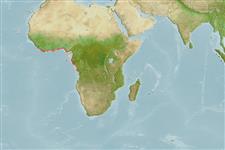Common names from other countries
>
Eupercaria/misc (Various families in series Eupercaria) >
Lutjanidae (Snappers) > Lutjaninae
Etymology: Lutjanus: Malay, ikan lutjan, name of a fish.
More on author: Duméril.
Environment: milieu / climate zone / depth range / distribution range
Ecologie
marien; brak water rifbewoner. Tropical; 7°N - 20°S, 15°W - 15°E (Ref. 55)
Eastern Atlantic: west coast of Africa (Ref. 57393), from Senegal to Angola (Ref. 81653), primarily in the Gulf of Guinea (Ref. 55, 57393, 81653), rarely appearing in Senegal (Ref. 57393). Mesoprion retrospinis Valenciennes, 1830 may be the oldest name for this species as the original description agrees closely to that given by Delais, 1952.
Grootte / Gewicht / Leeftijd
Maturity: Lm ? range ? - ? cm
Max length : 150 cm TL mannelijk / geslacht onbekend; (Ref. 81653); common length : 50.0 cm TL mannelijk / geslacht onbekend; (Ref. 55); max. gepubliceerd gewicht: 50.0 kg (Ref. 4320)
Dorsale stekels (totaal) : 10; Dorsale zachte stralen (totaal) : 13 - 14; Anale stekels: 3; Anale zachte stralen: 8. Diagnosis: body relatively deep (Ref. 81653). Head conical (Ref. 57393), slightly rounded, its dorsal profile curving gently (Ref. 55, 57393, 81653). Snout somewhat blunt (Ref. 57393, 81653). Preorbital/lachrymal bone broad (Ref. 55, 81653). Lips thick (Ref. 55, 57393, 81653). Vomerine tooth patch chevron-shaped in young individuals and triangular with a short postero-median prolongation in adults (Ref. 57393, 81653). Maxilla extending to about mid-eye level or beyond; preopercular notch and knob weak (Ref. 55, 81653). Pectoral fins of adult not reaching
level of anus (Ref. 81653). Scales moderate-sized (Ref. 57393, 81653). Scale rows on back rising obliquely above lateral line (Ref. 55, 57393, 81653). 4-5 scale rows above lateral line and below middle of spinous part of dorsal fin (Ref. 57393, 81653). 9-10 (transverse) scale rows on cheek (Ref. 55, 57393, 81653). Smokey gray on back and upper sides grading to whitish pink on lower sides and belly; sides of juveniles with a series of alternating light and dark bars of about equal widths (Ref. 55, 57393, 81653).
Adults inhabit rocky bottoms and coral reefs (Ref. 55, 57393, 81653). Also common in brackish lagoons and occasionally in rivers (Ref. 55, 81653), especially juveniles (Ref. 57393). Feed on fishes and crustaceans (Ref. 55, 81653).
Levenscyclus en paargedrag
Maturities | Voortplanting | Spawnings | Egg(s) | Fecundities | Larven
Allen, G.R., 1985. FAO Species Catalogue. Vol. 6. Snappers of the world. An annotated and illustrated catalogue of lutjanid species known to date. FAO Fish. Synop. 125(6):208 p. Rome: FAO. (Ref. 55)
Status op de Rode Lijst van het IUCN (Ref. 130435)
CITES (Ref. 128078)
Not Evaluated
Gevaar voor de mens
Harmless
Gebruik door de mens
Visserij: visserij voor eigen gebruik; sportvis: ja
Tools
Speciale rapporten
Download XML
Internetbronnen
Estimates based on models
Preferred temperature (Ref.
115969): 22.9 - 28, mean 27.4 (based on 26 cells).
Fylogenetische diversiteitsindex (Ref.
82804): PD
50 = 0.5000 [Uniqueness, from 0.5 = low to 2.0 = high].
Bayesian length-weight: a=0.01585 (0.00898 - 0.02799), b=2.96 (2.82 - 3.10), in cm Total Length, based on LWR estimates for this species & Genus-body shape (Ref.
93245).
Trofisch niveau (Ref.
69278): 4.0 ±0.66 se; based on food items.
Weerstandsvermogen (Ref.
120179): Zeer laag, minimale populatieverdubbelingstijd meer dan 14 jaar (Preliminary K or Fecundity.).
Fishing Vulnerability (Ref.
59153): Very high vulnerability (90 of 100).
